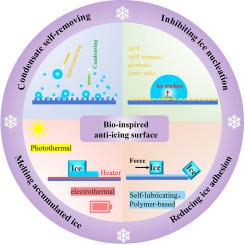Advances in Colloid and Interface Science ( IF 15.9 ) Pub Date : 2022-08-16 , DOI: 10.1016/j.cis.2022.102756 Shanshan Jiang 1 , Yunhe Diao 1 , Huige Yang 1

|
The need for improved anti-icing surfaces is the demand of the time and closely related to many important aspects of our lives as surface icing threatens not only industrial production but also human safety. Freezing on a cold surface is usually a heterogeneous nucleation process induced by the substrate. Creating an anti-icing surface is mainly achieved by changing surface morphology and chemistry to regulate the interaction between the surface and the water/ice to inhibit freezing on the surface. In this paper, recent research progress in the creation of biomimetic anti-icing surfaces is reviewed. Firstly, basic strategies of bionic anti-icing are introduced, and then bionic anti-icing surface strategies are reviewed according to four aspects: the process of ice formation, including condensate self-removing, inhibiting ice nucleation, reducing ice adhesion, and melting accumulated ice on the surface. The remaining challenges and the direction of future development of biomimetic anti-icing surfaces are also discussed.
中文翻译:

仿生防冰表面的最新进展
对改进的防冰表面的需求是时代的需求,并且与我们生活的许多重要方面密切相关,因为表面结冰不仅威胁工业生产,而且威胁人类安全。在冷表面上的冻结通常是由基材引起的异质成核过程。创建防冰表面主要是通过改变表面形态和化学成分来调节表面与水/冰之间的相互作用以抑制表面冻结。本文综述了近年来在仿生防冰表面创建方面的研究进展。首先介绍了仿生防冰的基本策略,然后从四个方面对仿生防冰表面策略进行了综述:冰的形成过程,包括冷凝水自排除、抑制冰核化、减少冰的粘附,并融化表面上的积冰。还讨论了仿生防冰表面的剩余挑战和未来发展方向。















































 京公网安备 11010802027423号
京公网安备 11010802027423号